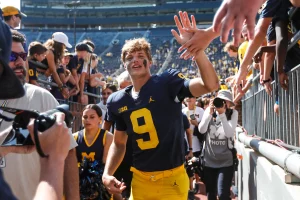
Condolence To The Family Of Our Great WR.
Sherrone Moore and his Michigan football coaching staff have serious momentum on the recruiting trail, landing seven commitments over a two-week span.
On the latest “Wolverine Confidential” podcast, MLive’s Aaron McMann, Ryan Zuke and Andrew Kahn recap the five commitments that came in before Monday. They discuss each player, interesting trends and facts and figures in relation to the haul.
Michigan had over double-digit visitors on campus for Victors Weekend, which also included several commits in town like Oak Park (Ill.) Fenwick four-star defensive lineman Nathaniel Marshall.
The talented 6-foot-4, 265-pounder verbally pledged to the Wolverines in April following his unofficial visit for the spring game.
Fit and opportunity remain everything in the college basketball transfer portal. The examples are endless on both ends of the spectrum. Tyler Burton was a top-10 transfer in the 2023 portal cycle, but he struggled to make a huge impact for a Villanova squad that was jam-packed with wings galore. Kadin Shedrick was another highly-coveted transfer who couldn’t get on the floor a ton at Texas because of Dylan Disu’s brilliance.
It happens.
Ranking players who enter the transfer portal is a tough, thankless exercise. But it often feels incomplete to not go back and double-check which players made the right decisions to maximize their impact next year. Player A might be higher-ranked than Player B, but Player B’s situation could be better than Player A’s which leads to a better year.
Burton was ranked a few slots higher than Dalton Knecht in the 2023 cycle. But Tennessee’s situation was far better than Villanova’s, and Knecht took the opportunity and ran with it. He’ll hear his name called in Wednesday’s 2024 NBA Draft.
How can we use this situation to impact portal grades moving forward? First, we split up the top commits in the portal into 10 different positions:
Initiator point guard: This archetype is usually one of the set-the-table guards who owns a high assist rate. As modern basketball adapts, a pass-first, point guard seems to be shifting toward the back burner, but there will always be room in our beautiful game for ’em. More often than not, your initiating point guard can get buckets, but he doesn’t walk onto the floor needing to get buckets. His job is to help get his team the best shot possible, whether for himself or others. A heavy dose of pick-and-roll usage is usually a big part of their repertoire.
Example: Purdue’s Braden Smith.
Combo guard: These guards can certainly handle the rock but are also fully comfortable playing next to an initiating point guard. Some teams have been getting away with having multiple combo guards on the floor together to share the point guard burden, but you might need an alpha wing and a stretch big man to make it work the best. The best combo guards can do a little bit of everything well offensively.
Example: UNC’s RJ Davis.
Shooting guard: This guard is on the floor to shoot the cover off the ball. Being a high-level, catch-and-shoot assassin certainly helps open up the floor, but if they can make shots on the move, that raises the profile even more. Great offenses can use creative sets to free up elite snipers who only need an inch of space, but these guards likely would struggle if they had to handle the bulk of the initiating duties.
Example: UConn’s Jordan Hawkins.
True wing: True wings usually have one or two things they do extremely well, but the top options are a handful on both ends of the floor. A true wing can guard multiple positions, scaling up or down based on opposing personnel. It’s helpful when a true wing can knock down shots from all areas of the floor, but being a knockdown shooter isn’t necessarily a must-have option. True wings can create for themselves, but also flash some ideal play-finishing abilities, too. You need your true wing to rebound, create, score and defend, so they better have great positional size and be one of the best athletes on the floor.
Example: Illinois’ Terrence Shannon Jr.
Scorer/creator: Bucket-getter. This is usually a hooper who can create offense out of thin air. They can pass a bit and share some of the ball-handling load, but their job is to score, by any means necessary. The most optimal version of these players are three-level scorers who can play on or off the ball. The elite ones can beat you in pick-and-rolls, or down in the paint (maybe using some bootyball) or anywhere they can find an advantage.
Example: Tennessee’s Dalton Knecht
Wing handler: These archetypes can periodically be a non-traditional point guard on offense, but they usually defend wings or forwards. Wing handlers are comfortable making reads, and they can usually be vital pieces to pressure weaker links of an opposing defense, but they aren’t always top-of-the-scouting report guys.
Example: Colorado’s Cody Williams







